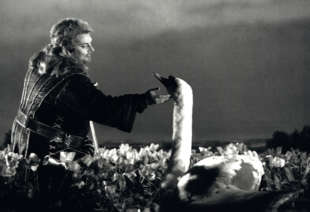Speight’s Wagner Memories: 94 LOHENGRIN

Ben Heppner (Lohengrin) and ensorcelled Gottfried von Brabant in Wagner’s Lohengrin, 1994
© Gary Smith
Lynch and Wadsworth had another idea, carried out by the shop and technical staff of Seattle Opera. I had told them that I wanted a swan. I was sick of Lohengrins where the swan, a vital element of the plot, was a light or a shadow or nothing. Lynch designed an animatronic swan, about 1/3rd bigger than the largest swan known, that sailed on a few inches of water between two fields of tulips. I don’t know whether anyone else ever had used tulips in Lohengrin, but what could be more natural in that area of the world? In execution, the swan brought tears to the eyes of many who saw it. It was one of the most exciting visual coups that Seattle Opera has produced in my years here. One factor that made it so remarkable was that the water and the tulips were all hidden behind great doors which opened just before Lohengrin’s entrance. They opened again in the final scene when it was time for him to leave, with the swan appearing on cue.
Wadsworth wanted the first act to be a Greek play with the chorus on a huge balcony above, reacting to everything that the principals sang. It took hours of intensive labor in rehearsal, but in performance the attention of the chorus, turning precisely as each principal sang, concentrated the audience on the drama. The time flew by, and we received a taste of the kind of intense person-to-person acting that, with the cooperation of a great cast, could bring Wagner to vivid life.
Heppner could only be called extraordinary; in all his performances his tenor defined an ideal Swan Knight. Gruber made a full-voiced, opulent Elsa, matching him note for note. This production also marked the debut of an artist very important to Seattle Opera, Greer Grimsley. Originally, he was only supposed to do five of the eight performances. Because of a health problem suffered by the alternative singer, Grimsley agreed to sing all eight Telramunds, two or three of them on successive days. Nothing could better testify to his excellent technique and strong constitution; Telramund is one of the most difficult and exhausting baritone roles in opera. Carol Yahr, the Ortrud, was his partner and gave a brilliant performance. Wadsworth emphasized their physical attraction to each other, and their evil had a dark, romantic edge.
Performing Lohengrin was a strange and gratifying experience. No Wagner opera is easy, but the last six operas he composed are such challenging monoliths that no one can ever really conquer them. One can do as well as possible and be given good marks for a good try, but no one will ever do a perfect Ring, Meistersinger, Tristan und Isolde, or Parsifal. Lohengrin, on the other hand, is more like a regular opera. Its vocal demands, though great, are more reasonable even than Tannhäuser’s, and its six roles can be cast. In our production of Lohengrin, I felt that we had scaled the mountain.